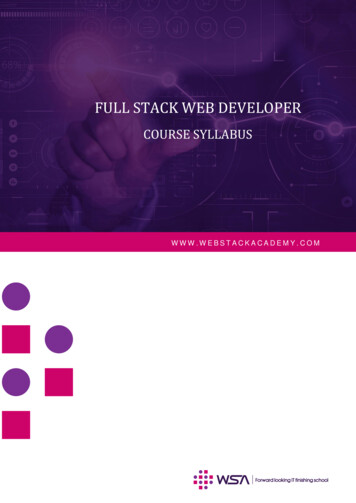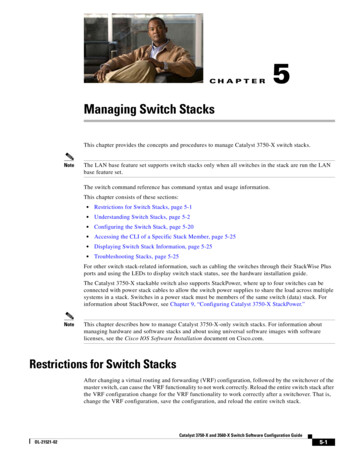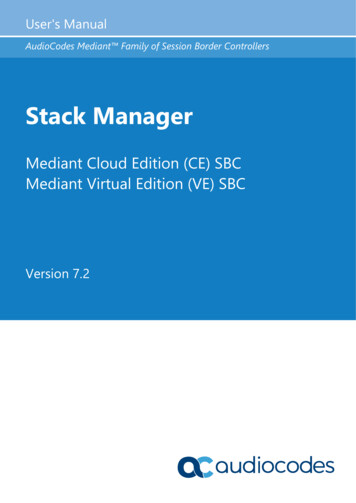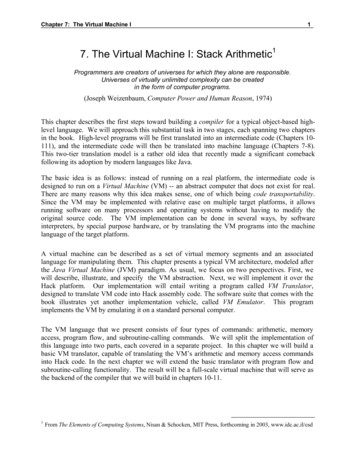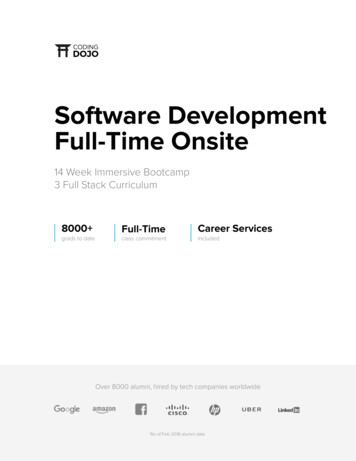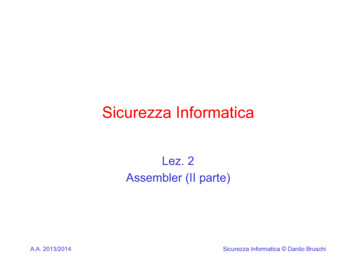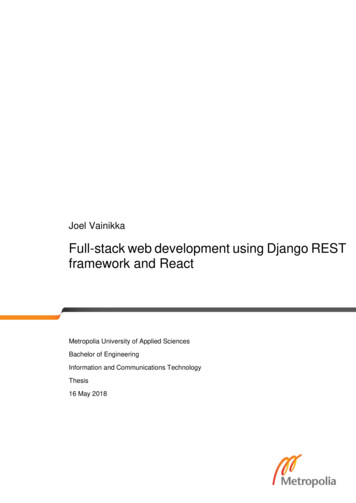
Transcription
Joel VainikkaFull-stack web development using Django RESTframework and ReactMetropolia University of Applied SciencesBachelor of EngineeringInformation and Communications TechnologyThesis16 May 2018
AbstractAuthorTitleNumber of PagesDateJoel VainikkaFull-stack web development using Django REST framework andReact34 pages 3 appendices16 May 2018DegreeBachelor of EngineeringDegree ProgrammeInformation and Communications TechnologyProfessional MajorSoftware EngineeringInstructorPeter Hjort, Senior LecturerThe purpose of this thesis was to investigate Finnish Esports League’s (FEL’s) web serviceand how it could be split into two separate services. FEL’s old service is on WordPress,which consists of two different sides, a news site and a tournament platform for Esportsplayers. The goal of the split is to ease further developing of the service and maintenance.Secondly, this study investigates full-stack development and frameworks chosen for the newproject.A full-stack developer is an expert who understands every aspect of the stack (toolset). Fullstack developing has been gaining popularity and stacks such as MEAN (MongoDB, Express.js, AngularJS, Node.js) have been favoured for their uniform programming language.A new service was built with Django REST framework. Building a complete service can beachieved with Django only, but the development team wanted to separate server and clientside. Therefore, REST was used for back-end, and the front-end application was createdwith React, which connects to back-end using REST API.The project did not end while writing this thesis, but the development continues. As an experience, working with Django REST was smooth. Splitting up server and front-end development was a good decision and it made developing easier and helped to manage the project. Because frameworks were new for the developers, getting to know them was time consuming.KeywordsDjango, Full-stack, Python, React, RESTful, WordPress
TiivistelmäTekijäOtsikkoSivumääräAikaJoel VainikkaFull-stack-verkkosovelluskehitys Django REST -sovelluskehyksen ja React-JavaScript-kirjaston avulla34 sivua 3 liitettä16.5.2018Tutkintoinsinööri (AMK)Tutkinto-ohjelmatieto- ja viestintätekniikkaAmmatillinen pääaineSoftware EngineeringOhjaajaLehtori Peter HjortInsinöörityön tarkoitus oli tutkia Suomen Elektronisen Urheilun Liigan (FEL) verkkopalveluaja sitä, miten se toteutettaisiin uudelleen jakamalla palvelu kahteen erilliseen osioon. FEL:nverkkopalvelun vanha järjestelmä toimi WordPress-kehyksellä ja sivusto koostui uutissivustosta ja pelaajille tarkoitetusta turnauspalvelusta. Jaon tarkoituksena oli hakea helpotustajatkokehittämiseen ja ylläpitämiseen. Samalla insinöörityössä tutkittiin, mitä on full-stack-sovelluskehittäminen ja mitkä sovelluskehykset valittiin uuteen projektiin.Full-stack-sovelluskehittämisellä tarkoitetaan, että sovelluskehittäjä hallitsee ohjelmistokehitysprojektin jokaisen osa-alueen ja kehitystyökalun. Full-stack-kehittämisestä on tullut suosittua, ja valmiita kehyspaketteja, kuten MEAN (MongoDB, Express.js, AngularJS, Node.js),suositaan niiden yhtenäisen ohjelmointikielen vuoksi.Uuden järjestelmän palvelinpuolta alettiin rakentaa Django REST -kehyksellä. Django-kehyksellä verkkosivujen luonti onnistuisi yksistään eikä vaatisi muita kehyksiä, mutta kehittäjät halusivat erottaa palvelinpuolen kokonaan käyttöliittymästä. Siksi selainpuolen näkymienhallintaan otettiin käyttöön React-kehys, jolla on helppo luoda itsenäinen ohjelmisto vainkäyttöliittymää varten. Se ottaa yhteyden palvelimeen REST-rajapinnan kautta.Lopullinen järjestelmä oli insinöörityöraporttia kirjoitettaessa vielä kesken ja sen työstäminenjatkui. Kokemuksena Django REST- ja React-kehyksillä työskentely oli sujuvaa. Palvelin- jaselainpuolen ohjelmiston jakaminen erilleen oli hyvä ratkaisu, ja se helpotti kehittämistä jaylläpitämistä. Koska kehitysalustat olivat kehittäjille uusia, ongelmia esiintyi lähinnä vain uusien kehyksien kanssa työskentelyssä. Uusiin kehyksiin tutustuminen vei kehityksessä aikaa.AvainsanatDjango, Full-stack, Python, React, RESTful, WordPress
ContentsList of Abbreviations1Introduction12Finnish Esports League22.1Service Introduction22.2Service elopment Frameworks103.1Full-Stack Development103.2Virtual Development Environment113.3Project Tools133.3.1Django Framework133.3.2PostgreSQL Database163.3.3React Library173.3.4Bootstrap CSS173.3.5Git Version Control18Project184.1Proposition184.2Project Goal204.3Setting Up Development Environments204.3.1Front-end Environment204.3.2Back-end Environment214.45ProblemsProject Example234.4.1Django Apps234.4.2Django Serializer284.4.3React Connection to API29Experiences and Thoughts31
65.1Problems and Considerations315.2Final Thoughts32ConclusionReferencesAppendicesAppendix 1. File team/views.pyAppendix 2. Swagger API toolAppendix 3. TeamList React component3335
List of AbbreviationsAPIApplication programming interfaceFELFinnish Esports LeagueCMSContent Management SystemCSSCascading Style SheetCS: GOCounter-Strike: Global OffensiveHSHearthstoneHTMLHyper Text Markup LanguageJSONJavaScript Object NotationJSXJavaScript XMLMySQLMy Structured Query LanguagenpmNode packet managerpipPython packet managerRESTRepresentational state transferSPASingle page applicationUDPUser Datagram ProtocolURLUniform Resource Locator
11IntroductionStarting a new software project is always exciting, and there are currently many waysof creating content for the web. To choose the right frameworks can be a challenge.Although it is tempting to try out the newest and trendiest frameworks, it might not bethe smartest decision. Comparing different frameworks is time consuming and expertshave different views on what features a good framework should have.As frameworks in web development evolve, front-end and back-end frameworks tendto get tied to one another creating stacks of tools. As a result, there is a need for newkind of developers called full-stack developers. A full-stack developer is a developerwho understands every aspect of the full-stack and has a wide understanding of thedifferent parts of the project without having deep knowledge of every aspect of the project.This study investigates the structure of the web-service provided by Finnish EsportsLeague (FEL). The developer team decided to split the current website into two separate services to make it easier to manage the services in the future.This thesis investigates how frameworks are chosen and how a project gets started byusing certain frameworks. This study also focuses on what it is like to work with thechosen frameworks. The project is carried out by using Python’s Django REST framework and React JavaScript library.This project was commissioned by Finnish Esports League, when they decided to makea change to a new system. The study covers the choices that were made by the development team at the beginning of the project and how working with the chosen frameworks turned out. Finally, this project investigates how problems caused by heavy backend, messy front-end and lack of flexibility in system design were solved.
22Finnish Esports LeagueThis section investigates what Finnish Esports League is and what kind of services theyprovide. Also, problems in the current system are listed and finally, a proposal for replacement will be presented.2.1Service IntroductionFinnish Esports League (FEL) is a small company founded in 2015, which aims at promoting Esports in Finland by organizing seasonal leagues and small tournaments forcomputer and console games. Two main games that the company organizes are Counter-Strike: Global Offensive (CS: GO) and Hearthstone (HS) but they also have tournaments for games such as FIFA and NHL. FEL writes its own news about ongoing leaguesand things that are currently going on in the Finnish competitive Esports scene.This study investigates the structure of the web-service provided by Finnish EsportsLeague. The developer team decided to split the current website into two separate services to make it easier to manage the services in the future. The purpose of the webservice is to provide news for fans. Also, players login and register their teams to tournaments through this website.Just as in any sports there are two types of competitions on the FEL’s web-service, individual and team-based sports. Esports games such as CS: GO and HS are good examples of both types of competitions, because they have special characteristics that needto be taken into consideration when making a service that tries to generalise a servicedesign.Counter-Strike: Global OffensiveCounter-Strike: Global Offensive (CS: GO) is a first-person shooter (FPS) game developed by Hidden Path Entertainment and Valve Corporation. The game is fourth in theseries and was released in August 2012 [1.] and has since grown to be the one of themost viewed Esports game to date according to Newzoo. [2.]
3In the game two teams, the Terrorists and the Counter-Terrorists play against each other.Both teams have their own objectives such as defusing or plating a bomb, but the winnerof one round can be decided when one team eliminates the other one before the objective is completed or time runs out.CS: GO Tournament RulesIn tournament matches, the basic rules of Electronic Sports League’s (ESLs) are applied.One tournament can, for example, be ran in a single-elimination bracket with each matchplaying out as a best-of-three series.In the game there are seven maps in the official map pool. Of these seven maps, thenumber of maps played in one match is decided by series. A best-of-three series mapveto is illustrated in figure 1.Figure 1.Illustration of a best-of-three match’s map veto process.Rules of map veto vary, but the above demonstrated method is the most common wayto veto maps. One played map consists of 30 rounds and teams switch sides after 15rounds. The first team to get 16 rounds wins. In case of draw, usually six rounds overtimeis played until winner is decided.Although the rules stay unchanged, tournament structure and map veto vary in eachtournament. Complexity of the CS: GO’s tournament rules are one critical factor to benoted in the match automation. Designing a static service for creating one type of tournament makes it challenging to make changes or organizing other types of tournamentsin future.
4HearthstoneHearthstone is digital card collection game developed by Blizzard Entertainment. Thegoal of the game is to defeat the opponent’s hero character by using cards. The playerhas a deck of 30 cards the content of which is based on selected hero. There are nineheroes in the game, which are unlocked by playing the game. Each hero also has somespecial skill in their use. [3.]At the beginning of the game both players have 30 health points and three to four cards,depending who starts first. Using cards and hero’s special skill requires mana points.Each round player’s mana points reset, and player receives one card from deck. At thebeginning both players have one mana point to use, which raises every round by one upto maximum of ten. [3.]Hearthstone Tournament RulesHearthstone uses last hero standing format, which is essentially a best-of-five series.Both players choose four heroes (card decks), after which they both ban one hero? foreach other. After that, the players choose the starting deck. The winning player continueswith the winning deck and the loser picks one deck from remaining decks available.2.2Service StructureThe current FEL service runs on WordPress. It connects with a third-party CS: GO serverrent service called Dathost and the eBot match manager. These services are used toautomate matches.2.2.1FrameworksThis section investigates which frameworks were used to build the FEL service. It alsodiscusses the reasons for choosing them.
5WordPressWordPress is an open source content management system (CMS) which was releasedin 2003. It is written on PHP programming language and uses My Structured Query Language (MySQL) database for data storing. WordPress is widely used to create blogs andnews sites. According to WordPress website, it is also the platform of choice for over30% of all sites across the web. [4.] A content management system (CMS) is a softwarefor managing content. It usually includes features such as content creation and editing.[5.]The community around WordPress has grown since its initial release and now there aretens of thousands of plugins and thousands of themes available. [6; 7] This makes it anexcellent choice for people who have limited tech experience to get a webpage up andrunning. [4.]For Finnish Esports League (FEL), applying WordPress was an excellent choice of platform to start running the business. When a team of professional writers started publishingnews about Esports, they started to get visibility.AngularJSAngularJS in an open source JavaScript framework developed by Google. [8, 3] AngularJS uses Model–view–controller (MVC) architecture for building web applications. [9,2.] Because of these characteristics, AngularJS is an excellent choice for single-pageapplications (SPAs). SPA webpages are generated by user iteration and do not requirethe whole page to load again, but to render the page again based on the data.AngularJS was added to FEL service during the development to help showing data inreal time. It is used to fetch real-time data for frontpage widget of ongoing leaguematches and a league match-page to show map veto in real time. This removes a needfor user to refresh the page manually to see if the opponent team has made a choice.
6Bulma CSS frameworkBulma is a free and open source Cascading Style Sheet (CSS) framework based onFlexbox. [10.] Bulma offers a variety of building blocks for creating flexible designs.CSS framework is a compilation of pre-set rules for Hyper Text Markup Language(HTML) styling. Commonly CSS frameworks come packed with a grid system, whichallows easily to build a webpage out of boxes that will scale on desktop and mobile devices. Larger frameworks include certain styling so keeping up a consistent look for website is made effortless.2.2.2StructureAs mentioned earlier, the FEL service operates on WordPress, which is heavily modifiedfor FEL’s use. The service connects with some third-party services such as a CS: GOserver rent service called Dathost and a match manager called eBot. This section investigates the structure trough out an example of how FEL service handles one leaguematch for CS: GO.eBoteBot is a tool to help in CS: GO server automation and make it easier to create matcheswith given configurations. eBot requires its own server and SQL-database to operate.This eBot server is then linked with the game server host through a control panel. TheeBot server should be located close to the game server, because eBot uses User Datagram Protocol (UDP) connection. Because this is an unreliable protocol, packet loss cancause problems with the matches.FEL league consists of a set number of matches, where each team competes againstone another during the league season. FEL creates all these league matches at thebeginning of league season. Each match has specified starting date by default on Sundays at 6 PM. This date can be changed of both teams agree on this.On the match day, once captain from both teams has checked in 30 minutes prior tostarting time, back-end calls Dathost’s Application programming interface (API) to startup the server. The next back-end waits until map veto between two teams is done. After
7map veto, FEL service adds match with configurations to eBot’s database through SQLinsert query. After the match is created, it is started with another SQL query and eBotestablishes UDP connection to the game server. The structure of the service as well asthe connections to third-party services is shown in figure 2 below.Figure 2.The service structure and its connections to third-party services.When one match is over, eBot stores the results of the match in its own database. Thisinformation can later be fetched if needed. Servers shut down automatically after onehour of idle time.Without CS: GO, the service could run alone without any connections to other third-partyservices, because all the other games rely on users setting up the match with given rulesand informing service about the result. This is as far as automation can go with gamessuch as HS, FIFA and NHL. Since Valve has given the rights for customers to host theirown servers to Valve’s games, this has allowed the business to grow on server rental.2.3ProblemsPointing out a single problem can be difficult, because several small problems tend toaccumulate. This chapter discusses why these problems exist and how they togethercreate larger problems. The current service is a well-functioning system but comes withsome drawbacks such as customization and flexibility of the service.
8CSS ConflictsCSS conflicts are not a rare thing in front-end development. There are ways to avoidthem and some good practices to keep the CSS reusable and consistent. In FEL’s caseeverything that should not be done, was done and everything that can conflict, did.FEL uses Vantage theme by SiteOrigin, which was later discovered in development toconflict with Bulma CSS framework as well as other CSS frameworks. While Bulma’sgrid components worked just fine, other components of the framework conflicted with theVantage theme. The problem laid in generic class names that happened to be same inBulma and Vantage theme. This made Bulma mostly useless.All this had caused overwriting CSS stylings inline all over the project files, which causedan enormous search operation when making minor changes to styles. The theme alsoconflicted with other frameworks, and the options were to write own styles or fix conflicts.Request OverflowDevelopment team realized that WordPress was not the best choice of platform for thistype of automated service. There was a need to bring more tools to help the creatingprocess which complicated things. One of those complications was AngularJS, whichwas used to refresh data in real time.There was a need to refresh data in real time on match pages where participants cansee who has checked in to upcoming match. Also, map veto needs to refresh data in realtime, and the frontpage needed a widget to show ongoing league matches in real time.This caused a vast number of requests to database.Because default time for league matches was set on Sunday evening, most of the teamsaccepted that the match will be played at that time. This caused a rush hour once a weekon Sunday evening. Requests made frequently by frontpage and match page causedthe server to crash on multiple occasions.
9MaintenanceThe service relies on number of different third-party widgets and plugins that are used toshow the social media feed and configure WordPress settings. Updating these shouldbe easy through the admin panel and in a normal situation this is how it will be done, asshown in figure 3 below.Figure 3.The WordPress admin panel plugin manager.In the initial stages of the development a decision was made that the whole WordPressproject would be in Git version control. This means that every time there is an update toany third-party plugin, it must be first updated on local development environment, whichis then pushed to version control master branch and later moved to the server where theservice is hosted. After all that the plugins had to be restarted manually to get themrunning right again. This was probably the easiest problem to avoid in the first place.Service FlexibilityThe service was built in a hurry; thus, it was not as flexible as developers wanted. Building the service was started with minor changes such as chancing CS: GO map pool oradding a new game for users to compete in. These two cases are discussed below.Changing CS: GO’s map pool required developers to edit the maps directly to the sourcecode. Even though chance such as this is never made in a hurry, it is something thatanyone should be able to change if they have the rights. Data which can change overtime, should never be hardcoded.
10FEL wants to keep adding new games for the player to compete. Adding a new game toFEL service was quite tricky as well. Knowing that each game will be handled almost inthe same way resulted in repeated code, which was then modified slightly to differentgames.3Development FrameworksThis section investigates full-stack development and what development environment virtualization means. Also, the frameworks, which were chosen for the FEL’s new projectwill be discussed in this section.3.1Full-Stack DevelopmentFull-stack development is rarely talked discussed as such; the different kinds of developers will also be dealt with. A full-stack developer is someone who understands everylayer of the full-stack. This includes not only front- and back-end but also project management, system infrastructure and databases. In summary a full-stack developer mighthave a wide knowledge of all the layers, instead of deep knowledge of a particular layer.[11.] Below is a quotation from an article in Udacity’s, which summarises full-stack developer well:Ultimately, what distinguishes a successful Full Stack Web Developer is not a superhuman ability to do everything, but rather, to understand everything. [12.]One of the most popular older stacks is LAMP, which includes Linux operating system,Apache HTTP Server, MySQL database and PHP programming language. The samestack for Windows is called WAMP and on macOS MAMP. [13.] When LAMP was released, the stack size was small, and at that time it was enough to build dynamicwebpages. Since then stacks have grown to be bigger and more demanding for developers.A good example of ready stacks is MEAN (MongoDB, ExpressJS, AngularJS, NodeJS),which was first introduced by MongoDB developer Valeri Karpov in 2013. The idea behind this stack was to have a uniform language through the whole stack, which in thiscase was JavaScript. This makes it easier for the developer to work on both ends of theproject. [14.]
11Defining usual stacks is difficult. Seeing some new-comers like Python Django on serverside and React trying to compete against Angular, it becomes increasingly a matter ofopinion of the developers to choose his or her own tools to build a stack instead of choosing a ready stack. LAMP and MEAN are still in use and they are the first ones to comeacross when trying to find out which stack to use. Since Django is written with Python,which is one of the most popular programming languages in the world, it has been growing popularity in web development. [15.]3.2Virtual Development EnvironmentThere are now more tools available than ever before and installing development environment has become a new issue since every project might have a completely differenttoolset. Stacks now rely on packet managers and virtual environments which can reproduce a project specific environment effortlessly. Being able to reproduce developmentenvironments easily helps developers significantly; they know that the development environment works on any system.Tools such as Docker and Python’s virtualenv are important parts of full-stack, as wellas packet managers like Python packet manager (pip) and Node packet manager (npm)that allow installing dependencies effortlessly from dependency file. Example of Python’svirtualenv, where two versions of Python run inside virtual environments is illustrated infigure 4.Figure 4.Two separate Python projects running in virtual environments with different Pythonversions and included libraries.Although libraries could be installed globally to the system and imported, this may causeproblems if some older projects require an older version of some library. Environmentvirtualization solves that problem.
12DockerDocker is a platform originally developed for Linux but is also available for other operatingsystems. It serves people who need to run Linux and Windows based applications withcontainers. Containers are a way to virtualize applications, however the mechanismworks differently compared to virtual machines. Containers run natively on Linux andare more lightweight compared to a normal virtual machine, because it shares the host’skernel and does not require a guest operating system to be installed. [16.] The differencebetween a container and a virtual machine is illustrated in figure 5.Figure 5.Illustration of the difference between a container and a virtual machine. [16.]Docker isolates the program from the operating system; it is possible to install only thenecessary programs in the container, thus saving resources. Docker uses an imagecalled Dockerfile, which is used to configure the container. [17.]Other solutions, such as for example Vagrant, configure operating systems completely;Vagrant takes care of installing and configuring applications, as well as setting up thesystem configuration. Vagrant can thus also be used to configure virtual machines. [18.]This solution was used to create a development environment for the FEL’s WordPressservice.This approach is similar and a subset of Docker’s functionality: Docker also configuresan operating system (the container) using the Dockerfile and the chosen image. Additionally, it takes cares of managing the containers. [19.]
13Each member of the development team uses a different operating system; thus, Dockeris used to ensure the consistency of the development environments across different environments. The project was created from a Cookiecutter template, which ships with apre-configured Dockerfile and Django template, which was then modified for custom use.This will be further discussed in chapter 4.3.3Project ToolsMore programming languages are supporting web development, and this opens newpossibilities for the developers. This also complicates things, because there are nowmore tools available than ever before and choosing the tools for the project might beharder to decide.This section goes through the tools (stack), which were chosen for the FEL’s new project.The tools for this project were chosen around the idea of having a Representational statetransfer (RESTful) API server with separate client-side application.3.3.1Django FrameworkPython is a cross-platform, general-purpose, object-oriented programming language, increasing popular in sectors of mathematics, biophysics, machine learning and web development. Python programs are usually interpreted instead of compiled to platform-specific binaries which allows a fast development cycle.Django is a high-level open-source Python Web framework that encourages rapid development and clean, pragmatic design. [20.] Django was open-sourced in summer 2005.Project was supported by other open-source projects such as Apache, Python and PostgreSQL. [21.]Django is not a content-management-system (CMS) like WordPress or Drupal, whichare both big CMSs written in PHP. Quoting Django’s own website:For example, it doesn’t make much sense to compare Django to something likeDrupal, because Django is something you use to create things like Drupal. [22.]
14Although components of Django share CMS-like functionality, like the admin panel module, it does not qualify to be a CMS.Working with Django reminds of working with PHP. Django does not require any frontend frameworks for creating dynamic web-services because Django uses own templating language called Django template language (DTL), which is mixed with HTML. Djangocan be combined with other frameworks but is not necessary. [20.] This basic Djangoway to create web-services uses Model Template View (MTV) paradigm, which is essentially Model View Controller (MVC) with different terms [22.] as shown in figure 6.Typical MVCDjango MTV (file)ModelModel (models.py)ViewTemplate (template.html)ControllerView (views.py)Figure 6.Compares typical MVC and Django’s representation MVC.In the MVC paradigm, the model represents the data, the view shows it and the controllercontrols what is done to the data. The user sees the view and uses the controller tomodify the model, which is then updated in the view again. The model acts as the datastorage. This is illustrated in figure 7.Figure 7.Illustration of MVC concept. The client sees the view and interacts with the model.[24.]
15In a regular Django application, requests are directed by the urls.py config file. Djangoparses the Uniform Resource Locator (URL) and redirects the data to different modules.These modules include the view (controller), data models and templates. When creatinga new Django module (app) it creates a folder with app’s name and the file structure.Template files are not created because the view.py can be used to render HTML as well.Making the app easier to manage, it is good practise to create separate templates folders and include the HTML templates in to the views.py.Django REST FrameworkBy default, Django is not ideal for building RESTful APIs, because it does not ship witha straightforward way to build APIs. Instead, there is a collaboratively funded side projectcalled Django REST framework. Django REST framework is a powerful and flexibletoolkit for building Web APIs. Although free to use, it is encouraged to fund the projectwhen creating commercial projects. [25.]By using Django REST framework, the MVC logic is moved to the front-end side. Thisframework transforms Django's role in the stack to that of a server; it does not displayany content but is only responsible for handling requests from the client for providing andmodifying data. RESTful API is illustrated in figure 8.Figure 8.Shows data flow of a RESTful API. [26.]The view (the controller) no longer renders the data (the model) into the view, insteadthe data is serialized and retrieved by the view itself. The view takes care of rendering
16this serialized data (the model), it becomes clear that the view is now re
stack developing has been gaining popularity and stacks such as MEAN (MongoDB, Ex-press.js, AngularJS, Node.js) have been favoured for their uniform programming language. A new service was built with Django REST framework. Building a complete service can be achieved with Django only, but the development team wanted to separate server and client .
